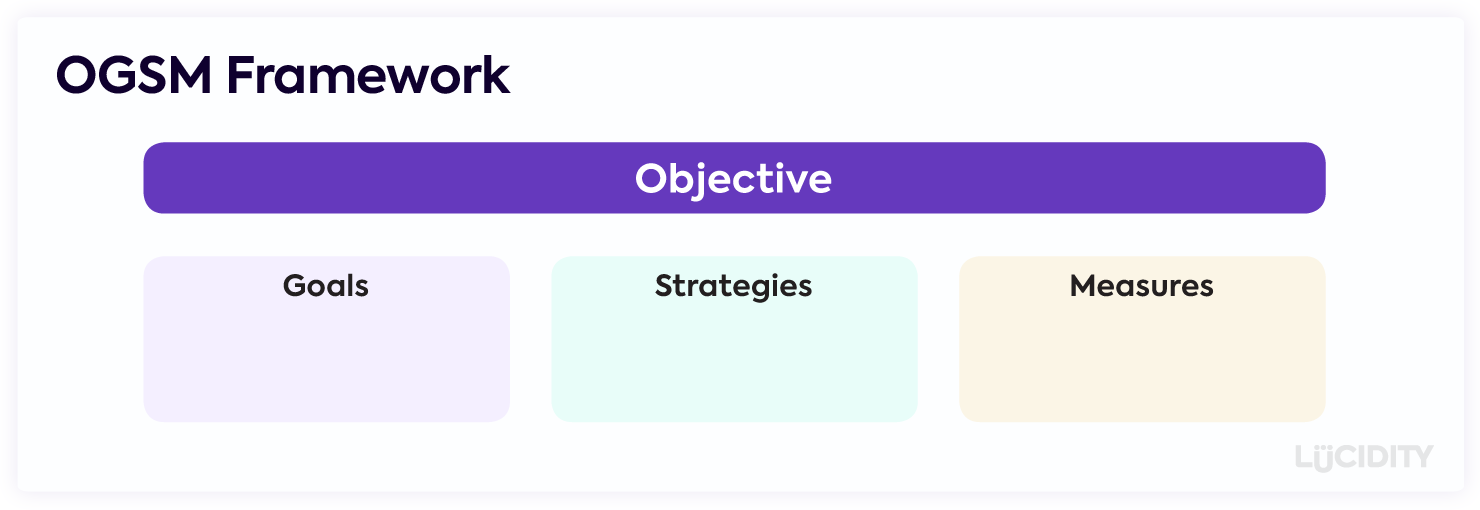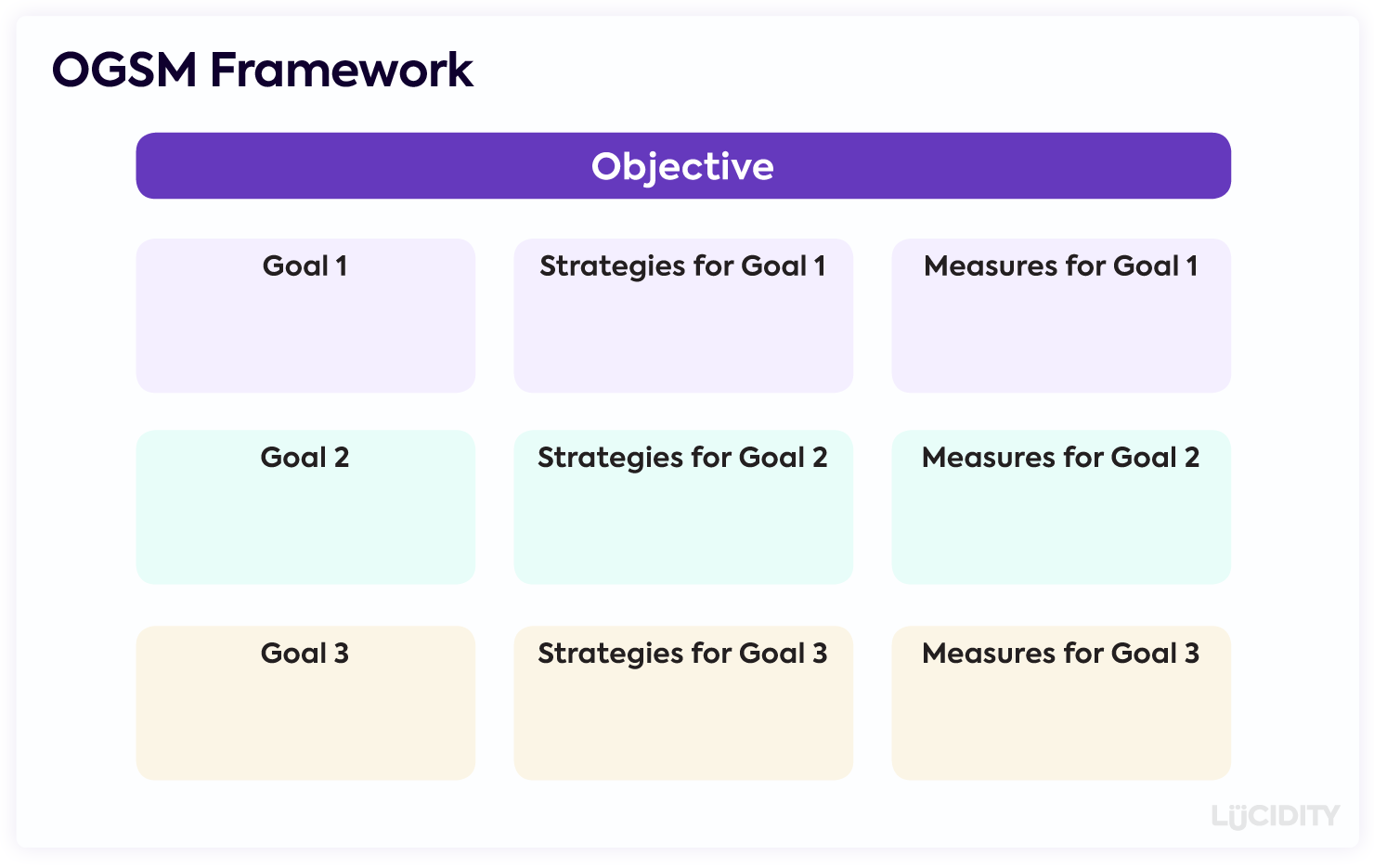The art of Strategy is all about breaking down your top level vision to a series of individual steps, in order to make it happen. It’s about getting from A to B in an effective and efficient way. The OGSM Framework is designed with exactly that in mind and is used by companies to execute their strategic plans. Let’s take a look in more detail…

What is the OGSM Framework?
The OGSM Framework is a tool used to translate your major objectives into individual actions. It’s used by companies to execute their strategy effectively and make sure the work they are doing is moving the business strategically forward. It’s a planning approach that helps turn a bold statement of ambition into a series of targets, actions and measures that will make that overarching vision a reality.
OGSM stands for:
- Objective
- Goals
- Strategies
- Measures
In this model you start with an Objective and then align Goals, Strategies and Measures to it. The original model was constructed around a single Objective, much like the Vision of the company, whereas more modern implementations use multiple Strategic Objectives.
As well as helping business leaders translate a Vision into a coherent strategic plan for the whole company, the OGSM Framework is often used by individual teams to plan their particular contribution and translate the top level Objective into the day-to-day tasks that they will focus on. It’s a useful tool when you are given an overarching statement of the company’s ambition, but not much else.
What are Objectives in the OGSM Framework?
The first part of the OGSM Framework is the Objective. This is akin to a Vision Statement or Mission Statement, it’s a defining and clear view of what the business is trying to achieve.
It’s important your Objective is:
- Clear and easy to understand
- Short and easy to remember
- In line with the wants of the shareholders
- Emotive and engaging
There are many tips on how to define your Vision statement in our Ultimate Guide to Vision Statements, a lot of which can be applied to the Objective in the OGSM Framework. So take a look at that to help you craft and refine a clear and motivating Objective statement to kick-start your OGSM work.
In other models, such as the Strategy Tree, you may have a number of Strategic Objectives. But in the pure OGSM model, there is just one sole, overarching objective.
Remember, your Objective in the OGSM Framework is a big, bold, ambitious statement about the long-term future of your business. You need to think big and present a strong and clear focus for everything else that follows in the OGSM process.

What are Goals in the OGSM Framework?
The Goals in the OGSM Framework are the specific targets you are trying to achieve. They are always measurable, always aligned to the success of the company, and should be linked to the overall Objective statement. If your Goals are all met then, in theory, your Objective statement becomes a reality. So what are the specific things that need to be true for that Objective statement to become an accurate description of your company?
Let’s say you had an Objective which was ‘To be the world’s most loved and widely used design software, that continues to delight it’s customers with truly innovative features that keep them at the cutting-edge of their profession’. Then some areas around which you should set specific Goals would be:
- Revenue
- Market share
- Customer satisfaction
- Churn rates
- Product development
Goals are always specific and measurable. So, looking at the above areas you wouldn’t have a goal that said “Low churn rates”, you’d instead say “Churn rate below 1%”, as an example. And with a product development related Goal, you would specify specific features that you want to develop and deploy by a specific date.
Specific and measurable Goals might be:
- Grow company revenue to $32M by FY25
- Achieve 70% market share by Q4
- Increase Customer Satisfaction score by 20 points by end of FY22
- Keep churn rate below 1% from Q3
- Release new collaberative whiteboard feature by Q2 FY23
What are Strategies in the OGSM Framework?
It’s always slightly confusing when a strategy framework uses the term Strategies for one component, after all isn’t the total sum of all these parts a strategy in itself? We certainly think it is. However, within the OGSM Framework, Strategies refers to the projects, initiatives and actions being taken to support the success of the Goals and the overall Objective.
Some examples might be:
- Installing a new CRM to support improving customer engagement
- Hiring a new team to develop a new product
- Opening an office to support international expansion
- Automating invoicing to improve efficiency
So for each Goal identified at the previous stage of your OGSM work, you’ll need a list of Strategies that will help you hit that Goal. Somewhere in the region of three to five Strategies per Goal is probably right, but it will, of course, depend on how much work is required to hit your target and achieve that Goal.
Strategies in the OGSM Framework are all about the execution. It’s where you develop the individual actions that will move your Goal progress and make your Objective a reality. So, if you had a Goal to increase your Customer Satisfaction score by 20 points, then the Strategies that align to that might be:
- Organise a customer event
- Set up automated anniversary campaigns
- Implement a new NPS survey mechanism

What are Measures in the OGSM Framework?
The final part of the OGSM Framework, Measures, focuses on the ways you are tracking success. What are the KPIs you’re using to judge whether the execution is working? These are the metrics you need to watch as your plan unfolds to stay on top of progress and quickly assess whether you’re on track or need to troubleshoot or adjust things.
If your Goals are time-bound – as, ideally, they should be – then your Measures are the key performance indicators that you need to watch as you move towards that Goal deadline. It’s no good setting your Goals, working through your Strategies and not assessing progress until you hit the deadline. You need to have a clear Measure, or multiple Measures, for each Goal so you know your Strategies are working and you’re making progress. That way, if things are not moving forward, you can reassess your Strategies and try different tactics to ensure you do hit that deadline after all.
Goals could have a number of KPIs associated to them. If we return to our previous example, a Goal of ‘Increasing Customer Satisfaction by 20 points’ could have a number of different KPIs attached to it. Clearly there is the actual Customer Satisfaction score or NPS, but there would also be other Measures relating to the Strategies that you’ve mapped out to help your customers feel happier about your product or service.
One of those Strategies was ‘run a customer event’. Measures you would use to judge the success of that Strategy and whether it was going to help improve the Customer Sat score would be things like:
- Invitation open rates
- Registration numbers
- Attendee numbers
- Social media mentions
- Post-event suvey responses
So for each and every Goal you have mapped out so far in your OGSM Framework, now list out all the specific metrics you will need to monitor in order to assess whether the Strategies are working and you’re going to succeed.
Unsure of what to measure? Take a look at our Ultimate Guide to KPIs for lots of potential measurement options.
Alongside what you measure, you should also consider how you will do that measuring. How will you track and report these metrics? It’s important with the OGSM Framework – indeed with any strategic planning tool – that everything is clear and concise. If any strategy plan is going to succeed, it needs to be as quick and easy to understand as possible so everyone knows what they’re aiming for and what they need to do. The Measures part of OGSM is no exception. You want to make sure that all the metrics being tracked are easily available and simple to understand. Visual dashboards are an effective way to monitor your strategic progress and ensure you don’t spend all your time reporting rather than executing!
What are the advantages of the OGSM Framework?
The OGSM Framework is a great approach when it comes to adding structure to a strategy, with advantages including:
- It’s a clear and easy structure to follow
- It condenses a strategic plan to one page
- It enables easy visibility and reporting on progress
- It ties everything together, from vision through to execution
- All activities listed are moving the business forward
- It helps with internal communication of the strategy plan
What are the disadvantages of the OGSM Framework?
There are some disadvantages of the framework, such as:
- The terminology can be confusing between Objective/Strategies/Vision/Projects
- As OGSM is designed to monitor progress towards Goals, you need some supporting setup or software to get the most from it
- The single layer of one Objective to multiple Goals is quite restrictive vs other frameworks that have multiple objectives or layers
What are the alternatives to the OGSM Framework?
The OGSM Framework is a sound approach to strategic design but there are more modern, agile frameworks that may be better suited. Take a look at The Strategy Tree or Strategy Map as two potential alternatives.
Who invented the OGSM Framework?
Although it’s not completely clear, most people agree that the OGSM Framework was developed in Japan during the 1950s. Since then it’s been used by many major companies, proving it’s effectiveness to implementing strategic plans.
So, now you understand the OGSM Framework, one of the many different tools and frameworks to help structure a strategic plan and achieve your business goals. Another approach is to build your strategy in the Lucidity strategy software which includes all the integrated tools you need to set goals, plan initiatives, track KPIs and manage the execution.
Sign up to your free trial and we’ll automatically generate a strategy plan based on your business and your ambitions. So, have a go and see if that’s the ideal solution for structuring your strategy. We think you’ll like it 😉

Book your personal demo today
Let us show you how easy it is to structure your strategy with the OGSM Framework in Lucidity













